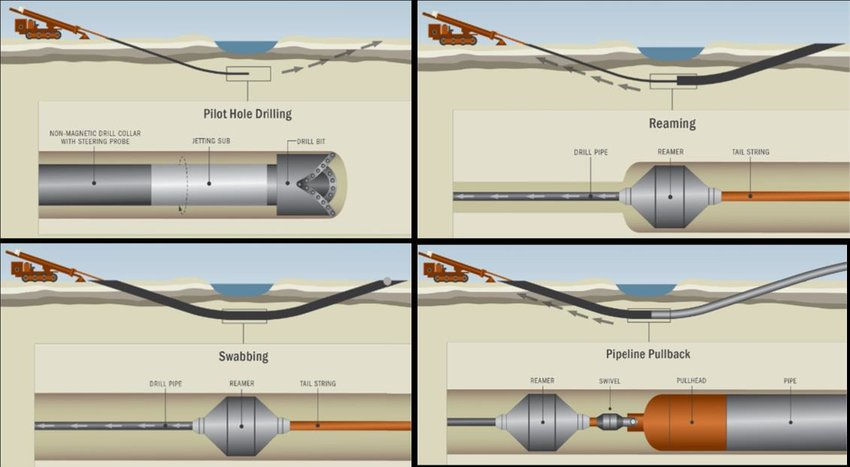Why Horizontal Directional Drilling is the Future of Trench less Technology?
- Grid Tech
- Aug 9, 2023
- 3 min read
In the world of underground infrastructure development and construction, trench less technology has emerged as a game-changer. Offering innovative solutions to various challenges. Among these groundbreaking methods, Horizontal Directional Drilling (HDD) stands out as a true game-changer. HDD has revolutionized the way we approach underground construction, bringing numerous benefits that make it the future of trench less technology.
Gone are the days of disruptive and costly open-cut methods that required extensive excavation, leading to environmental disturbances and inconvenience for communities.
HDD offers a smarter, more efficient, and Eco-friendly approach to installing underground utilities and pipelines.
So, today here in this blog post, we are going to explore the compelling reasons why Horizontal Directional Drilling is paving the way for the future of trenchless technology and how it is set to transform the underground construction landscape.

Minimized Environmental Impact:
One of the key reasons why Horizontal Directional Drilling is the future of trenchless technology lies in its ability to significantly reduce the environmental impact associated with traditional construction methods.
With HDD process, there is minimal surface disruption, as the drilling process takes place underground, beneath roads, rivers and other obstacles. This not only preserves natural landscape but also protects sensitive ecosystems, reduces soil erosion and minimizes the risk of groundwater contamination.
By minimizing the destruction of habitats and preserving green spaces, HDD aligns with sustainable development goals, making it an eco-friendly choice for infrastructure projects.
Reduced project Costs and Timeframes:
Horizontal Directional Drilling offers cost-saving benefits compared to traditional open-cut methods. Although the initial investment in HDD equipment might be higher, the overall project cost is significantly lower due to reduced labor, material and restoration expenses.
Moreover, as the drilling process is streamlined and efficient, it expedites project timelines, allowing for quicker completion and reduced disruption to local communities. The ability to execute projects faster makes HDD an attractive option for municipalities, utilities and construction companies seeking efficient and cost-effective solutions.

Flexibility and Versatility:
Another reason HDD is gaining popularity as the future of trenchless technology is its versatility. This method is suitable for various soil conditions, including hard rock, clay and sand, making it adaptable to a wide range of projects. It allows engineers and contractors to navigate around existing infrastructure, such as utilities and pipelines, without disturbing them.
Additionally, HDD can accommodate various pipe sizes, which expands its applications to diverse industries like oil and gas, water supply, telecommunications and more. This flexibility offers a practical solution for complex projects that require precision and innovation.
Enhanced Safety Measures:
Safety is paramount in any construction endeavor, and HDD provides several safety advantages. Since the drilling process is carried out underground, workers are less exposed to potential hazards compared to traditional open-cut methods.
This minimizes the risk of accidents and injuries on the job site. Moreover, HDD reduces the likelihood of damage of existing utilities and structures, mitigating the risk of service disruptions and costly repairs. Enhanced safety measures not only protect workers and the public but also contribute to overall project success and client satisfaction.
Aesthetics and Community Acceptance:
Horizontal Directional Drilling is a welcome solution for projects that require minimal surface disruption and aesthetic considerations. The non-invasive nature of HDD ensures that roads, parks and other public spaces remain largely undisturbed during the construction process.
As a result, communities are more accepting of projects that utilize HDD, reducing potential conflicts and opposition. The ability to maintain the visual appeal of neighborhoods and urban areas while carrying out essential infrastructure development makes HDD a favored choice for public projects.

Conclusion
So, there is no surprise that Horizontal Directional Drilling has proven itself as the future of trenchless technology for several compelling reasons. Its ability to minimize overall environmental impact, reduce costs and timeframes, adapt to various soil conditions and enhance safety measures has positioned it as a preferred method for underground construction. With a growing emphasis on sustainability, efficiency and community acceptance, HDD aligns perfectly with the needs of modern infrastructure development.
As the world faces increasing challenges in urbanization and expanding infrastructure demands, Horizontal Directional Drilling offers a viable solution to meet these requirements effectively.
So, embracing this trenchless technology ensures that construction projects progress with minimal disruption to the environment and communities, fostering a brighter, more sustainable future for underground infrastructure development.


Comments